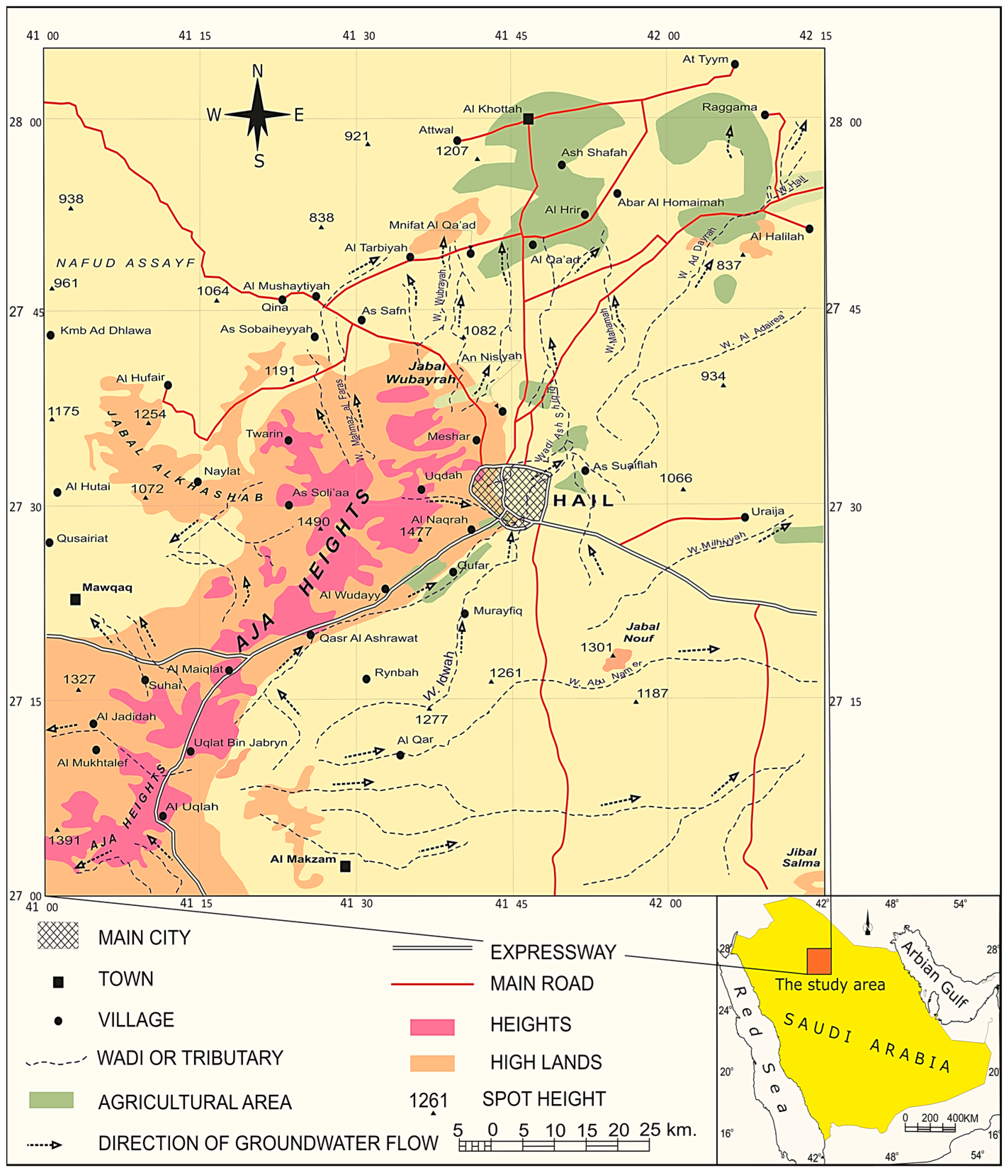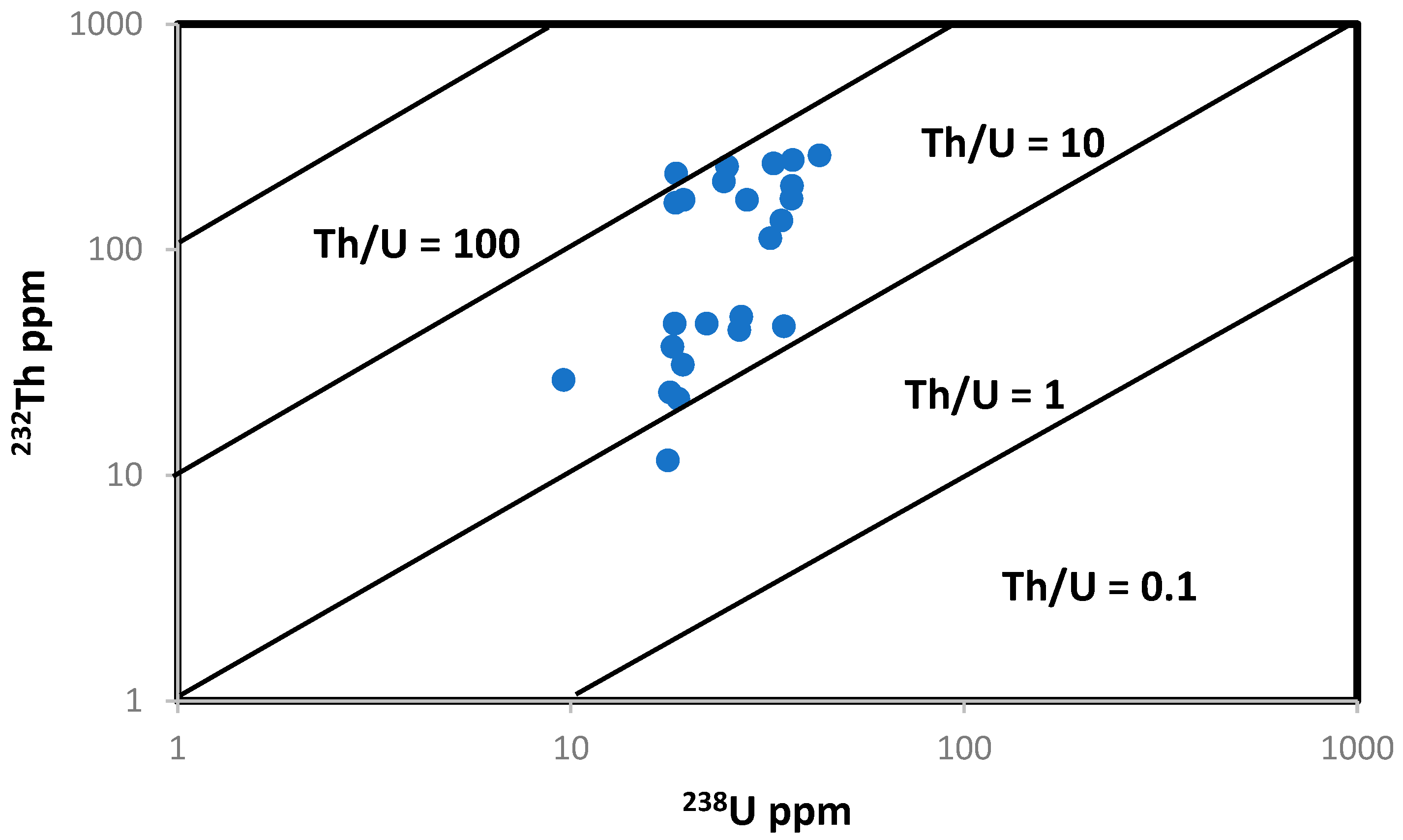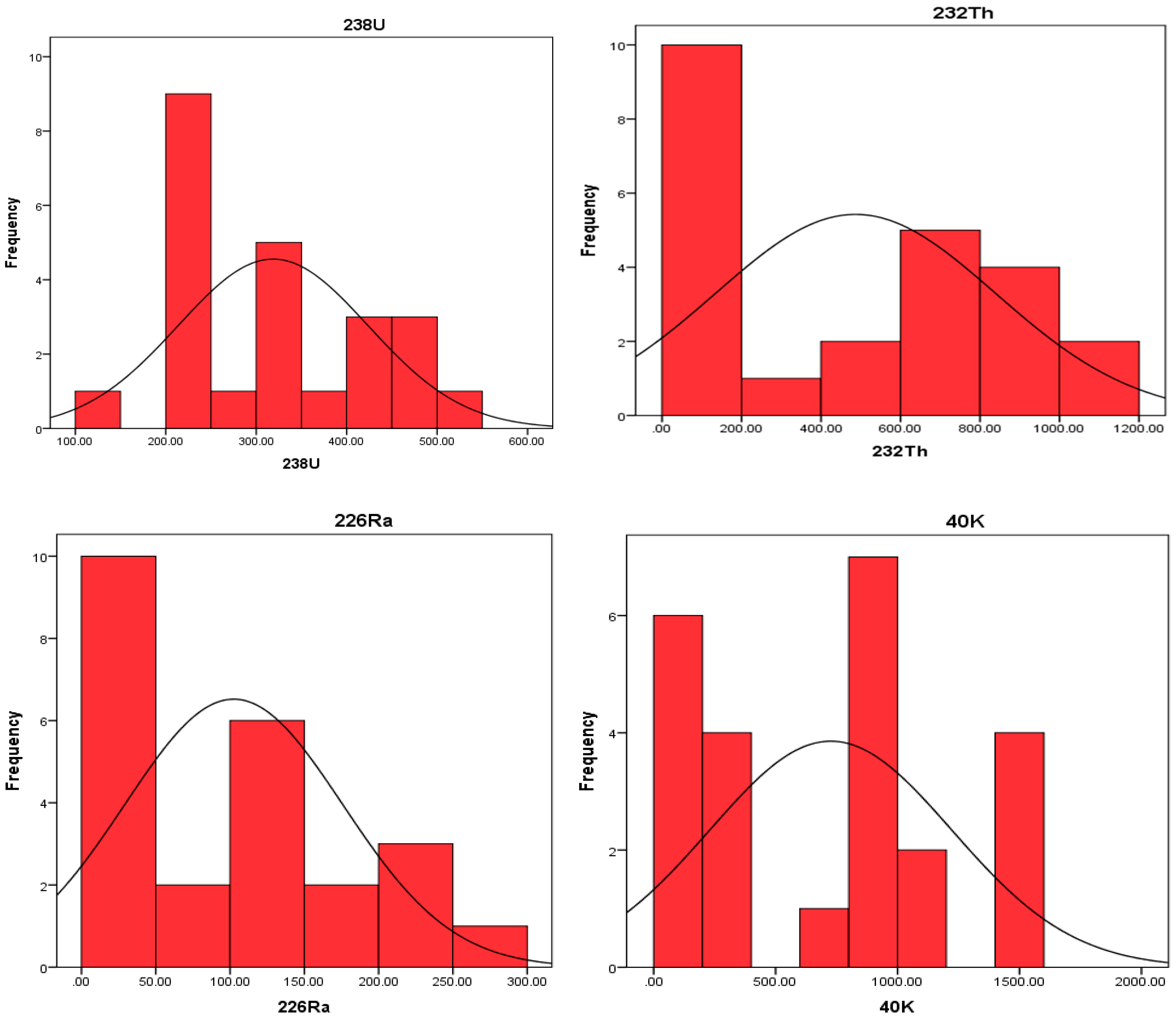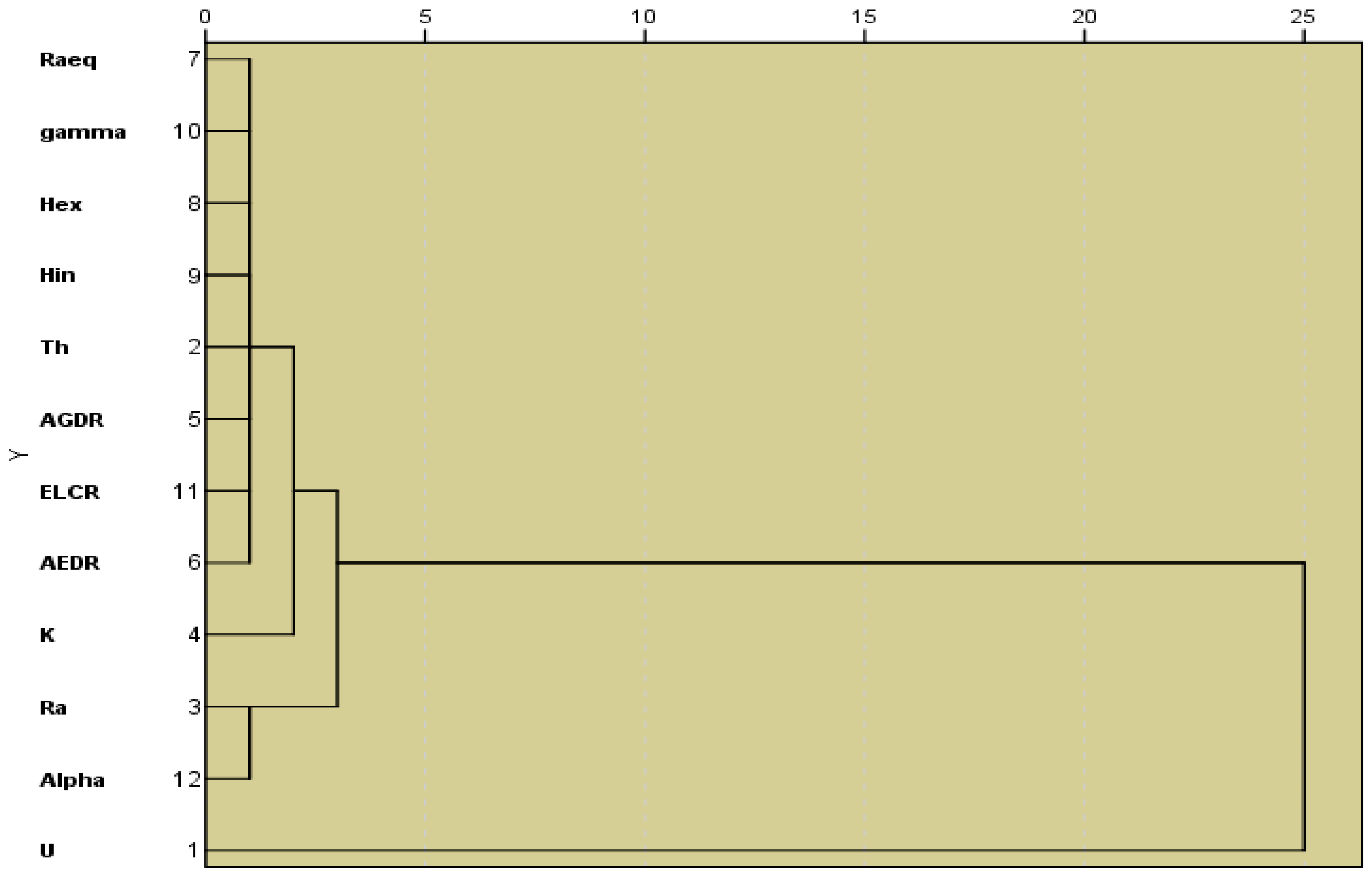Evaluation of Environmental Radioactivity and Hazard Impacts Saudi Arabia Granitic Rocks Used as Building Materials
Abstract
1. Introduction
2. Materials and Methods
2.1. Geological Settings
2.2. Analytical Methods
2.3. Environmental Hazard Impacts
3. Results and Discussion
3.1. Radionuclides Activity Concentrations
3.2. Environmental Hazard Impacts Results
4. Conclusions
Author Contributions
Funding
Data Availability Statement
Acknowledgments
Conflicts of Interest
References
- El Galy, M.M. Mobilization of some radioelements and its implication on their favorability, case study on selected granitic plutons, Central Eastern Desert, Egypt. Sci. J. Fac. Sci. 2007, 21, 19–38. [Google Scholar]
- Sonkawade, R.; Kant, K.; Muralithar, S.; Kumar, R.; Ramola, R.C. Natural radioactivity in common building construction and radiation shielding materials. Atmos. Environ. 2008, 42, 2254–2259. [Google Scholar] [CrossRef]
- Turhan, S.; Kurnaz, A.; Karata ̧slı, M. Evaluation of natural radioactivity levels and potential radiological hazards of common building materials utilized in Mediterranean region, Turkey. Environ. Sci. Pollut. Res. 2022, 29, 10575–10584. [Google Scholar] [CrossRef] [PubMed]
- Aykamı¸s, A.S.; Turhan, S.; Aysun Ugur, F.; Baykan, U.N.; Kılıç, A.M. Natural radioactivity, radon exhalation rates and indoor radon concentration of some granite samples used as construction material in Turkey. Radiat. Prot. Dosim. 2013, 157, 105–111. [Google Scholar] [CrossRef] [PubMed]
- Moghazy, N.M.; El-Tohamy, A.M.; Fawzy, M.M.; Awad, H.A.; Zakaly, H.M.H.; Issa, S.A.M.; Ene, A. Natural Radioactivity, Radiological Hazard and Petrographical Studies on Aswan Granites Used as Building Materials in Egypt. Appl. Sci. 2021, 11, 6471. [Google Scholar] [CrossRef]
- UNSCEAR. Sources and Effects of Ionizing Radiation: Sources; United Nations Publications: New York, NY, USA, 2000; Volume 1. [Google Scholar]
- Lasheen, E.S.R.; Hesham, M.H.Z.; Alotaibi, B.M.; Saadawi, D.A.; Ene, A.; Fathy, D.; Awad, H.A.; El Attar, R.M. Radiological Risk Parameters of the Phosphorite Deposits, Gebel Qulu El Sabaya: Natural Radioactivity and Geochemical Characteristics. Minerals 2022, 12, 1385. [Google Scholar] [CrossRef]
- Abbasi, A. Calculation of gamma radiation dose rate and radon concentration due to granites used as building materials in Iran. Radiat. Prot. Dosim. 2013, 155, 335–342. [Google Scholar] [CrossRef]
- Kinsara, A.A.; Shabana, E.I.; Qutub, M.M.T. Natural Radioactivity in Some Building Materials Originating from a High Background Radiation Area. Int. J. Innovat. Edu. Res. 2014, 2, 70–78. [Google Scholar]
- Hereher, M.E.; Al-Shammari, A.M.; Abd Allah, S.E. Land cover classification of Ha’il-Saudi Arabia using remote sensing. Int. J. Geosci. 2012, 3, 349–356. [Google Scholar] [CrossRef]
- EC. Radiation protection unit, radiological protection principles concerning the natural radioactivity of building materials. Radiat. Prot. 1999, 112, 5–16. [Google Scholar]
- Omar, A.; Burdin, S.; Casse, G.; Van Zalinge, H.; Powel, S.; Rees, J.; Smith, A.; Tsurin, I. GAMBE; Development of a hand-held thermal neutron detector using stacked silicon sensors coated with 6LiF films. Radiat. Meas. 2019, 129, 106–180. [Google Scholar] [CrossRef]
- Güna, O. Assessment of lifetime cancer risk from natural radioactivity levels in Kadikoy and Uskudar District of Istanbul. Arab. J. Geosci. 2018, 11, 782. [Google Scholar] [CrossRef]
- Günay, O.E.K.E. Determination of terrestrial radiation level and radiological parameters of soil samples from Sariyer-Istanbul in Turkey. Arab. J. Geosci. 2019, 12, 631–640. [Google Scholar] [CrossRef]
- Harpy, N.; Ragab, F.; Morsy, Z.; Abdel-Rahman, M.A.E. Factors Controlling Natural Radionuclides Migration in Sedimentary Rock Samples, Gabal Um-Hamd, Southwestern Sinai, Egypt. Int. J. Inorg. Chem. 2019, 645, 960–968. [Google Scholar] [CrossRef]
- Hilal, M.A.; Attallah, M.F.; Gehan, Y.; Mohamed, F.H.M. Evaluation of radiation hazard potential of TENORM waste from oil and natural gas production. J. Environ. Radioact. 2014, 136, 121–126. [Google Scholar] [CrossRef]
- Knoll, G.F. Radiation Detection and Measurement, 2nd ed.; Wiley: New York, NY, USA, 2000; Volume 11, p. 12. [Google Scholar]
- Madkour, H.A.; El-Taher, A.; Ahmed, A.N.; Mohamed, A.W.; El-Erian, T.M. Contamination of Coastal Sediments in El-Hamrawein Harbour, Red Sea, Egypt. J. Environ. Sci. Technol. 2012, 5, 210–221. [Google Scholar]
- Mansour, H.; Abd El-Azeem, S.A.; Harpy, N.M. Distribution of natural radionuclides for sedimentary rock samples from southwestern Sinai and their environmental impacts. Egypt. Int. J. Recent Sci. Res. 2017, 8, 21715–21721. [Google Scholar]
- Ahmed, A.; Burdin, S.; Casse, G.; Van Zalinge, H.; Powel, S.; Rees, J.; Smith, A.; Tsurin, I. GAMBE; multipurpose sandwich detector for neutrons and photons. Radiat. Detect. Syst. Appl. XVII 2016, 9969, 59–67. [Google Scholar]
- Mejjad, N.; Laissaoui, A.; El-Hammoumi, O.; Benmansour, M.; Benbrahim, S.; Bounouira, H.; Benkdad, A.; Bouthir, F.Z.; Fekri, A.; Bounakhla, M. Sediment geochronology and geochemical behavior of major and rare earth elements in the Oualidia Lagoon in the western Morocco. J. Radioanal. Nucl. Chem. 2016, 309, 1133–1143. [Google Scholar] [CrossRef]
- Solak, S.; Turhan, Ş.; Uğur, F.A.; Gören, E.; Gezer, F.; Yeğingil, Z.; Yeğingil, İ. Evaluation of potential exposure risks of natural radioactivity levels emitted from building materials used in Adana, Turkey. Indoor Built Environ. 2014, 23, 594–602. [Google Scholar] [CrossRef]
- Chabaux, F.; Granet, M.; Pelt, E.; France-Lanord, C.; Galy, V. 238U-234U-230Th disequilibria and timescale of sedimentary transfers in rivers: Clues from the Gangetic plain rivers. J. Geochem. Explor. 2006, 8, 373–375. [Google Scholar] [CrossRef]
- Wignall, P.B.; Meyers, K.J. Interpreting the benthic oxygen levels in mudrocks: A new approach. Geology 1988, 16, 452–455. [Google Scholar] [CrossRef]
- Ravisankar, R.; Chandramohan, J.; Chandrasekaran, A.; Jebakumar, J.P.P.; Vijayalakshmi, I.; Vijayagopal, P.; Venkatraman, B. Assessments of radioactivity concentration of natural radionuclides and radiological hazard indices in sediment samples from the East coast of Tamilnadu, India with statistical approach. Mar. Pollut. Bull. 2015, 97, 419–430. [Google Scholar] [CrossRef] [PubMed]
- Amin, R.M. Gamma radiation measurements of naturally occurring radioactive samples from commercial Egyptian granites. Environ. Earth Sci. 2012, 67, 771–775. [Google Scholar] [CrossRef]
- Al-Hamarneh, I.F. Radiological hazards for marble, granite and ceramic tiles used in buildings in Riyadh, Saudi Arabia. Environ. Earth Sci. 2017, 76, 516. [Google Scholar] [CrossRef]
- Turhan, Ş.; Köse, A.; Varinlioğlu, A.; Şahin, N.K.; Arıkan, İ.; Oğuz, F.; Yücel, B.; Özdemir, T. Distribution of terrestrial and anthropogenic radionuclides in Turkish surface soil samples. Geoderma 2012, 117–124, 187–188. [Google Scholar] [CrossRef]
- Aladeniyi, K.; Arogunjo, A.M.; Pereira, A.J.S.C.; Khandaker, M.U.; Bradley, D.A.; Sulieman, A. Evaluation of radiometric standards of major building materials used in dwellings of South-Western Nigeria. Radiat. Phys. Chem. 2021, 178, 109021. [Google Scholar] [CrossRef]
- Tuo, F.; Peng, X.; Zhou, Q.; Zhang, J. Assessment of natural radioactivity levels and radiological hazards in building materials. Radiat. Prot. Dosim. 2020, 188, 316–321. [Google Scholar] [CrossRef]
- Imani, M.; Adelikhah, M.; Shahrokhi, A.; Azimpour, G.; Yadollahi, A.; Kocsis, E.; Toth-Bodrogi, E.; Kovács, T. Natural radioactivity and radiological risks of common building materials used in Semnan Province dwellings, Iran. Environ. Sci. Pollut. Res. 2021, 28, 41492–41503. [Google Scholar] [CrossRef]
- Righi, S.; Bruzzi, L. Natural radioactivity and radon exhalation in building materials used in Italian dwellings. J. Environ. Radioact. 2006, 88, 158–170. [Google Scholar] [CrossRef]
- Kitto, M.E.; Haines, D.K.; Menia, T.A. Assessment of gamma-ray emissions from natural and manmade decorative stones. J. Radioanal. Nucl. Chem. 2009, 282, 409. [Google Scholar] [CrossRef]
- Sharaf, J.M.; Hamideen, M.S. Measurement of natural radioactivity in Jordanian building materials and their contribution to the public indoor gamma dose rate. Appl. Radiat. Isot. 2013, 80, 61–66. [Google Scholar] [CrossRef]
- Mabrouk, S.; Abd El Monsef, M.; Abart, R.; Toksoy-KÖksal, F.; Abdelfadil, K.M. Unraveling the Genesis of Highly Fractionated Rare-Metal Granites in the Nubian Shield via the Rare-Earth Elements Tetrad Effect, Sr–Nd Isotope Systematics, and Mineral Chemistry. ACS Earth Space Chem. 2022, 6, 2368–2384. [Google Scholar]
- Agbalagba, E.; Osakwe, R.; Olarinoye, I. Comparative assessment of natural radionuclide content of cement brands used within Nigeria and some countries in the world. J. Geochem. Explor. 2014, 142, 21–28. [Google Scholar] [CrossRef]
- Al-Zahrani, J. Estimation of natural radioactivity in local and imported polished granite used as building materials in Saudi Arabia. J. Radiat. Res. Appl. Sci. 2017, 10, 241–245. [Google Scholar] [CrossRef]
- Papadopoulos, A.; Christofides, G.; Koroneos, A.; Papadopoulou, L.; Papastefanou, C.; Stoulos, S. Natural radioactivity and radiation index of the major plutonic bodies in Greece. J. Environ. Radioact. 2013, 124, 227–238. [Google Scholar] [CrossRef]
- Ravisankar, R.; Raghu, Y.; Chandrasekaran, A.; Gandhi, M.S.; Vijayagopal, P.; Venkatraman, B. Determination of natural radioactivity and the associated radiation hazards in building materials used in Polur, Tiruvannamalai District, Tamilnadu, India using gamma ray spectrometry with statistical approach. J. Geochem. Explor. 2016, 163, 41–52. [Google Scholar] [CrossRef]
- Tzortzis, M.; Tsertos, H.; Christofides, S.; Christodoulides, G. Gamma radiation measurements and dose rates in commercially- used natural tiling rocks (granites). J. Environ. Radioact. 2003, 70, 223–235. [Google Scholar] [CrossRef]





| Samples | 238U Bq.kg−1 | 232Th Bq.kg−1 | 226Ra Bq.kg−1 | 40K Bq.kg−1 | 238U/226Ra | 232Th/238U | 238U ppm | 232Th ppm | 226Ra ppm | 40K ppm | Authogenic U (U-Th/3) | eU/eTh | eTh/eU | eU/eRa | eTh/K |
|---|---|---|---|---|---|---|---|---|---|---|---|---|---|---|---|
| 1 | 348 | 671 | 148 | 964 | 2.4 | 1.9 | 28.1 | 166.1 | 13.3 | 3.1 | −46.0 | 0.17 | 5.92 | 2.1 | 53.6 |
| 2 | 452 | 680 | 152 | 980 | 3.0 | 1.5 | 36.5 | 168.3 | 13.7 | 3.1 | −44.0 | 0.22 | 4.62 | 2.7 | 54.3 |
| 3 | 453 | 775 | 153 | 1110 | 3.0 | 1.7 | 36.5 | 191.8 | 13.8 | 3.5 | −51.8 | 0.19 | 5.25 | 2.7 | 54.8 |
| 4 | 304 | 810 | 204 | 998 | 1.5 | 2.7 | 24.5 | 200.5 | 18.4 | 3.2 | −58.7 | 0.12 | 8.18 | 1.3 | 62.7 |
| 5 | 407 | 975 | 207 | 1130 | 2.0 | 2.4 | 32.8 | 241.3 | 18.6 | 3.6 | −69.5 | 0.14 | 7.35 | 1.8 | 67.0 |
| 6 | 532 | 1058 | 144 | 1440 | 3.7 | 2.0 | 42.9 | 261.9 | 13.0 | 4.6 | −73.0 | 0.16 | 6.10 | 3.3 | 56.9 |
| 7 | 426 | 544 | 126 | 869 | 3.4 | 1.3 | 34.4 | 134.7 | 11.4 | 2.8 | −33.4 | 0.26 | 3.92 | 3.0 | 48.1 |
| 8 | 229 | 652 | 129 | 950 | 1.8 | 2.8 | 18.5 | 161.4 | 11.6 | 3.0 | −47.6 | 0.11 | 8.74 | 1.6 | 53.8 |
| 9 | 230 | 878 | 130 | 1432 | 1.8 | 3.8 | 18.5 | 217.3 | 11.7 | 4.6 | −66.3 | 0.09 | 11.72 | 1.6 | 47.2 |
| 10 | 310 | 945 | 210 | 1490 | 1.5 | 3.0 | 25.0 | 233.9 | 18.9 | 4.8 | −69.6 | 0.11 | 9.36 | 1.3 | 48.7 |
| 11 | 455 | 1010 | 255 | 1519 | 1.8 | 2.2 | 36.7 | 250.0 | 23.0 | 4.9 | −71.1 | 0.15 | 6.81 | 1.6 | 51.0 |
| 12 | 275 | 190 | 75 | 708 | 3.7 | 0.7 | 22.2 | 47.0 | 6.8 | 2.3 | −8.3 | 0.47 | 2.12 | 3.3 | 20.4 |
| 13 | 399 | 454 | 99 | 885 | 4.0 | 1.1 | 32.2 | 112.4 | 8.9 | 2.8 | −26.7 | 0.29 | 3.49 | 3.6 | 40.1 |
| 14 | 240 | 672 | 140 | 945 | 1.7 | 2.8 | 19.4 | 166.3 | 12.6 | 3.0 | −49.0 | 0.12 | 8.59 | 1.5 | 55.4 |
| 15 | 119 | 107 | 19 | 135 | 6.3 | 0.9 | 9.6 | 26.5 | 1.7 | 0.4 | −5.6 | 0.36 | 2.76 | 5.6 | 66.3 |
| 16 | 225 | 150 | 25 | 142 | 9.0 | 0.7 | 18.1 | 37.1 | 2.3 | 0.5 | −6.3 | 0.49 | 2.05 | 8.1 | 74.2 |
| 17 | 228 | 190 | 28 | 147 | 8.1 | 0.8 | 18.4 | 47.0 | 2.5 | 0.5 | −9.5 | 0.39 | 2.56 | 7.3 | 94 |
| 18 | 333 | 178 | 33 | 170 | 10.1 | 0.5 | 26.9 | 44.1 | 3.0 | 0.5 | −5.7 | 0.61 | 1.64 | 9.0 | 88.2 |
| 19 | 432 | 185 | 32 | 168 | 13.5 | 0.4 | 34.8 | 45.8 | 2.9 | 0.5 | −3.7 | 0.76 | 1.31 | 12.1 | 91.6 |
| 20 | 337 | 204 | 37 | 180 | 9.1 | 0.6 | 27.2 | 50.5 | 3.3 | 0.6 | −7.8 | 0.54 | 1.86 | 8.2 | 84.2 |
| 21 | 219 | 47 | 19 | 212 | 11.5 | 0.2 | 17.7 | 11.6 | 1.7 | 0.7 | 2.0 | 1.52 | 0.66 | 10.3 | 16.6 |
| 22 | 222 | 94 | 22 | 245 | 10.1 | 0.4 | 17.9 | 23.3 | 2.0 | 0.8 | −1.8 | 0.77 | 1.30 | 9.0 | 29.1 |
| 23 | 233 | 88 | 33 | 298 | 7.1 | 0.4 | 18.8 | 21.8 | 3.0 | 1.0 | −1.0 | 0.86 | 1.16 | 6.3 | 21.8 |
| 24 | 239 | 125 | 39 | 306 | 6.1 | 0.5 | 19.3 | 30.9 | 3.5 | 1.0 | −3.9 | 0.62 | 1.61 | 5.5 | 30.9 |
| Permissible limit [6] | 50 | 50 | 50 | 500 | -- | -- | -- | -- | -- | -- | -- | -- | -- | - | -- |
| Parameters | 238U (Bq.kg−1) | 232Th (Bq.kg−1) | 226Ra (Bq.kg−1) | 40K (Bq.kg−1) |
|---|---|---|---|---|
| N | 24 | 24 | 24 | 24 |
| Minimum | 119 | 47 | 19 | 135 |
| Maximum | 532 | 1058 | 255 | 1519 |
| Mean | 318.6 | 486.8 | 102.5 | 726 |
| Std. deviation | 105.1 | 352.9 | 73.4 | 496.5 |
| Skewness | 0.56 | 0.46 | 0.85 | 0.29 |
| Kurtosis | −0.90 | −1.74 | −1.12 | −1.58 |
| Median | 307 | 499 | 112.5 | 877 |
| Countries Names, References | 238U (Bq.kg−1) | 232Th (Bq.kg−1) | 226Ra (Bq.kg−1) | 40K (Bq.kg−1) |
| Egypt [26] | 137 | 82 | -- | 1082 |
| Saudi Arabia [27] | 54.5 | 43.4 | -- | 677.7 |
| Turkey [28] | 45.4 | 82.3 | -- | 931.6 |
| Nigeria [29] | 74 | 100 | -- | 1098 |
| China [30] | 355.9 | 317.9 | -- | 1636.5 |
| Iran [31] | 38 | 47 | -- | 917 |
| Italy [32] | 81.33 | 129 | -- | 1065 |
| USA [33] | 31 | 61 | -- | 1082 |
| Jordan [34] | 41.5 | 58.4 | -- | 897 |
| Parameters | AGDR nG.h−1 | AEDR | Raeq | Hex | Hin | Iγ | ELCR | Iα |
|---|---|---|---|---|---|---|---|---|
| N | 24 | 24 | 24 | 24 | 24 | 24 | 24 | 24 |
| Minimum | 125.8 | 0.2 | 100.6 | 0.3 | 0.3 | 0.7 | 0.5 | 0.1 |
| Maximum | 1375.7 | 1.7 | 1795.5 | 4.9 | 5.6 | 12.8 | 5.6 | 1.3 |
| Mean | 651.03 | 0.80 | 844.46 | 2.31 | 2.58 | 6.04 | 2.64 | 0.52 |
| Median | 725.85 | 0.90 | 882.45 | 2.40 | 2.75 | 6.35 | 2.95 | 0.55 |
| Std. deviation | 452.63 | 0.56 | 604.08 | 1.65 | 1.85 | 4.30 | 1.84 | 0.37 |
| Skewness | 0.38 | 0.37 | 0.43 | 0.45 | 0.41 | 0.43 | 0.40 | 0.92 |
| Kurtosis | −1.74 | −1.74 | −1.77 | −1.76 | −1.76 | −1.77 | −1.71 | −0.98 |
| Permissible limit [6] | 55 | 0.48 | 370 | 1 | 1 | 2–6 | 0.29 × 10−3 | 1 |
Disclaimer/Publisher’s Note: The statements, opinions and data contained in all publications are solely those of the individual author(s) and contributor(s) and not of MDPI and/or the editor(s). MDPI and/or the editor(s) disclaim responsibility for any injury to people or property resulting from any ideas, methods, instructions or products referred to in the content. |
© 2023 by the authors. Licensee MDPI, Basel, Switzerland. This article is an open access article distributed under the terms and conditions of the Creative Commons Attribution (CC BY) license (https://creativecommons.org/licenses/by/4.0/).
Share and Cite
Fallatah, O.; Khattab, M.R. Evaluation of Environmental Radioactivity and Hazard Impacts Saudi Arabia Granitic Rocks Used as Building Materials. Minerals 2023, 13, 165. https://doi.org/10.3390/min13020165
Fallatah O, Khattab MR. Evaluation of Environmental Radioactivity and Hazard Impacts Saudi Arabia Granitic Rocks Used as Building Materials. Minerals. 2023; 13(2):165. https://doi.org/10.3390/min13020165
Chicago/Turabian StyleFallatah, Othman, and Mahmoud R. Khattab. 2023. "Evaluation of Environmental Radioactivity and Hazard Impacts Saudi Arabia Granitic Rocks Used as Building Materials" Minerals 13, no. 2: 165. https://doi.org/10.3390/min13020165
APA StyleFallatah, O., & Khattab, M. R. (2023). Evaluation of Environmental Radioactivity and Hazard Impacts Saudi Arabia Granitic Rocks Used as Building Materials. Minerals, 13(2), 165. https://doi.org/10.3390/min13020165






